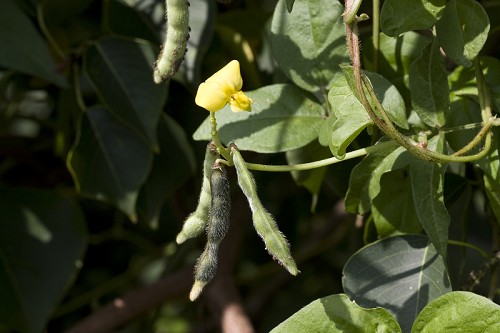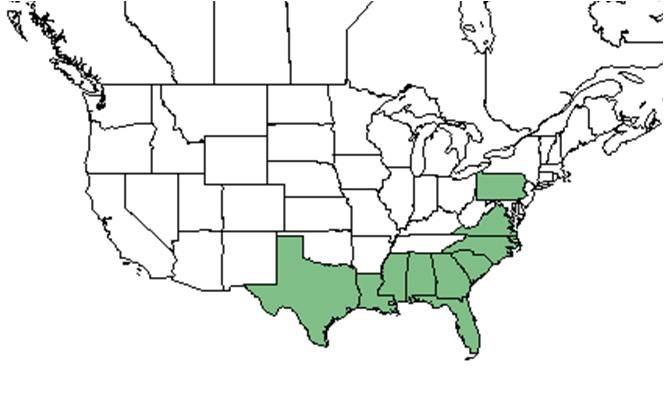Vigna luteola
| Vigna luteola | |
|---|---|

| |
| Photo by John R. Gwaltney, Southeastern Flora.com | |
| Scientific classification | |
| Kingdom: | Plantae |
| Division: | Magnoliophyta - Flowering plants |
| Class: | Magnoliopsida – Dicotyledons |
| Order: | Fabales |
| Family: | Fabaceae ⁄ Leguminosae |
| Genus: | Vigna |
| Species: | V. luteola |
| Binomial name | |
| Vigna luteola (Jacq.) Benth. | |

| |
| Natural range of Vigna luteola from USDA NRCS Plants Database. | |
Common names: Hairypod cowpea, Wild cow pea
Contents
Taxonomic notes
Synonyms: Vigna repens (Linnaeus) Kuntze; Vigna marina (Burmann) Merrill.[1]
Description
"Annual or perennial, trailing or climbing herbaceous vines (or occasionally erect). Leaves pinnately 3-foliolate; leaflets entire, stipellate. Racemes axillary usually long-pedunculate, with few to several closely clustered, papilionaceous flowers subtended by small, caduceus bracts and with paired, caduceus bractlets at or near the tops of the pedicels. Calyx campanulate, somewhat 2-lipped, the upper lobes partly or completely united, longer than the lateral but shorter than the lowermost lobe; petals yellow or purple, the keel petals curved but not spirally coiled, about as long as the wings and shorter than the auriculate standard; stamens diadelphous, 9 and 1; ovary sessile, style bearded along the upper surface. Legume linear, terete or slightly compressed.[2]
"Perennial with glabrous to retrorsely pubescent stems, 1-3 m long. Leaflets ovate or more commonly lanceolate to linear-lanceolate, 2-8 cm long, both surfaces more or less sparsely appressed-pubescent; stipules ovate-lanceolate to lanceolate, not extending below the point of attachment. Racemes on elongate peduncles usually several times longer than the subtending leaves and terminated by few to several, closely clustered flowers on retrorsely pubescent pedicels 1-3 mm long subtended by pubescent bracts 1-1.5 mm long and with pairs of 1-nerved, pubescent bractlets 1-1.5 mm long. Calyx the upper lobes united, 2 mm long, the lateral lobes ca. 1.5 mm long and the lowermost ca. 2.5 mm long; petals yellow, 1.4-1.8 cm long. Legume linear, 4-6.5 cm long, appressed-pubescent."[2]
Distribution
Found in the southeastern U.S., Texas; West Indies, Mexico, Central and South America.[3]
Ecology
Habitat
Vigna luteola occurs along bays, river banks, palmetto hammocks, bordering mangrove swamps, lagoon shores, salt marsh banks, scrub oak-palmetto near the coast, along seepage slopes, and coastal sea oats grasslands. It has also can be found in disturbed areas such as cleared borders of slash pine flatwoods and disturbed beaches.[4] It can be used as a short term legume in pastures, green manure, or as ley in croplands.[5] Prefers moist soils which include loamy sand, sandy loam, and oyster shells.[4] It is a major component of intermediate marshes and can shade out other perennials.[6] This species nodulates freely and effectively and releases nitrogen when it dies that can improve the growth of associated grasses.[7]
Associated species include Bidens laevis, Eupatorium perfoliatum, Aster puniceus, Rynchospora, Uniola paniculata, Helianthus debilis, and Paspalum.[4]
Phenology
Flowers and fruits February through November.[4][8]
It establishes a tripartite symbiosis with indigenous rhizobia and AM fungi for phosphorous uptake.[9] Hernandez et al. found that the most efficient fungus in promoting growth of V. luteola was Glomus mosseae.[10]
Seed dispersal
The legume pods are dehiscent.[5] Animals who eat the legumes can spread the seed in dung under favorable conditions of warmth and moisture.[7]
Fire ecology
It has been observed growing in recently burned pine woodlands.[4]
Pollination
Sweat bees such as Halictus poeyi (family Halictidae) and leafcutting bees such as Anthidium maculifrons, Coelioxys sayi, Dianthidium floridiense and Megachile sp. (family Megachilidae) were observed visiting flowers of Vigna luteola at the Archbold Biological Station.[11]
Herbivory and toxicology
V. luteola is a source of food for white-tailed deer.[12]
Diseases and parasites
This species can suffer from damage from catterpillars (Prodenia spp.) and jassids (Cicadellidae: Homoptera). In Australia, it can suffer from the peanut mottle virus.[5]
Conservation, cultivation, and restoration
It can be used for as a short term legume in pastures, green manure, or ley in croplands.[5]
Cultural use
Photo Gallery
References and notes
- ↑ Weakley, A.S. 2015. Flora of the southern and mid-atlantic states. Working Draf of 21 May 2015. University of North Carolina at Chapel Hill, Chapel Hill, North Carolina.
- ↑ 2.0 2.1 Radford, Albert E., Harry E. Ahles, and C. Ritchie Bell. Manual of the Vascular Flora of the Carolinas. 1964, 1968. The University of North Carolina Press. 639. Print.
- ↑ [[1]]Regional Conservation. Accessed: March 21, 2016
- ↑ 4.0 4.1 4.2 4.3 4.4 Florida State University Robert K. Godfrey Herbarium database. URL: http://herbarium.bio.fsu.edu. Last accessed: November 2015. Collectors: Loran C. Anderson, K.E. Blum, Sidney T. Brinson, Jane Brockmann, D. Burch, A.F. Clewell, C. Craighead, M. Darst, Delzie Demaree, Robert K. Godfrey, James W. Hardin, W.F. Humphrey, Norlan C. Henderson, Ann F. Johnson, Robert Kral, R.L. Lazor, Robert J. Lemaire, H. Loftin, Sidney McDaniel, Mary E. Nolan, Jackie Patman, Elmer C. Prichard, Paul Redfearn, William Reese, Alberto S. Taylor, S.D. Todd, Alfred Traverse, Edwin L. Tyson, D.B. Ward, Sarah V. Yinger. States and Counties: Alabama: Baldwin. Florida: Bay, Brevard, Clay, Dade, Flagler, Franklin, Hillsborough, Indian River, Lee, Manatee, Monroe, Palm Beach, Pinellas, Putnam, Sarasota, Volusia. Countries: Panama. Compiled by Tall Timbers Research Station and Land Conservancy.
- ↑ 5.0 5.1 5.2 5.3 [[2]]Tropical Forages. Accessed: March 21, 2016
- ↑ White, D. A. and M. J. Simmons (1988). "Productivity of the Marshes at the Mouth of the Pearl River, Louisiana." Castanea 53(3): 215-224
- ↑ 7.0 7.1 [[3]]Accessed: March 21, 2016
- ↑ Nelson, G. PanFlora: Plant data for the eastern United States with emphasis on the Southeastern Coastal Plains, Florida, and the Florida Panhandle. www.gilnelson.com/PanFlora/ Accessed: 19 MAY 2021
- ↑ Izaguirre-Mayoral, M. L., S. Flores, et al. (2011). "Rhizophagus manihotis promotes the growth of rhizobia-nodulated Vigna luteola L in phosphorus deficient acid montane soils devoid of ground cover vegetation." Symbiosis 55(1): 1-9.
- ↑ Hernández, G., G. Cuenca, et al. "Behaviour of arbuscular-mycorrhizal fungi on Vigna luteola growth and its effect on the exchangeable (32P) phosphorus of soil." Biology and Fertility of Soils 31(3): 232-236.
- ↑ Deyrup, M.A. and N.D. 2015. Database of observations of Hymenoptera visitations to flowers of plants on Archbold Biological Station, Florida, USA.
- ↑ Cite error: Invalid
<ref>tag; no text was provided for refs namedeol